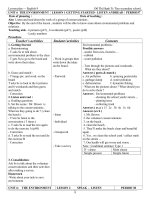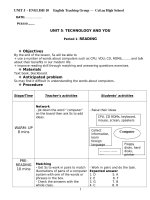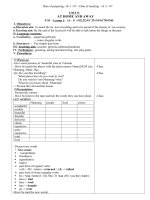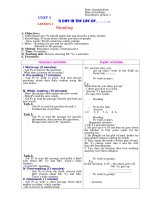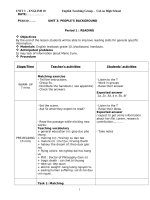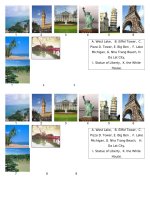Giao an -Unit 9
Bạn đang xem bản rút gọn của tài liệu. Xem và tải ngay bản đầy đủ của tài liệu tại đây (492.16 KB, 16 trang )
Unit 9 UNDERSEA WORLD
Date of preparing: January,4th
Date of teaching: January,9th
Period: 1
st
A. READING
I. AIMS AND OBJECTIVES:
- Language content:
+ To introduce the students some new words relating to undersea world.
+ To help Ss understand the content of the text.
- Language function:
+ To talk about the type of sea creatures and undersea life: size, feeding habits, offspring, life span,
special features.
- Educational aims:
+ To educate Ss to be aware of protecting the environment.
1. Language:
a.Vocabulary: cover, challenge, mystery, investigate, sample ,biodiversity, maintain, at stake divide into
b.Structures: The conditional type 2
2. Skills: Intergrated skills
3. Education factor :
+ To help Ss know how to protect sea creatures.
II. TEACHER AND STUDENTS’ PREPARATION:
1. Method: Communicative approach
2. Techniques: Explaination, Repetition, using pictures, group work, pairwork, gap-filling
3. Materials needed: textbook, pictures of fish.
4. Students preparation: Prepare some pictures and information about some species of fish.
III. PROCEDURE IN CLASS:
1.Stabilization: (3mn) - Greeting.
- Checking about absence.
2. Checking up the previous knowledge: - No
Teaching steps
and time
Teacher’s activities Students’
activities
The lesson content
I. Presentation
of the new
materials
* Warm-up
(5mn)
- Gives a game “Grouping
game” .
- Asks Ss to look at the
pictures and arrange the
animals into two groups.
- Work in group.
- Listen.
- Work with a
partner.
+ Đại Tây Dương
+ Thái Bình Dương
+ Ấn Độ Dương
+ Bắc Cực
+ Nam Cực
Unit 9:
UNDERSEA WORLD
A. READING
1. New words.
+ cover (v): che phủ
+ challenge(v): thách thức
+ investigate (v): điều tra,
nghiên cứu
+ maintain (v): duy trì
+ divide into = fall into
+ mystery(n): điều thần bí,
bí ẩn
+ sample (n): mẫu vật
* Pre-reading
(10mn)
* While-reading
( 10mn)
- Introduces the theme of
the lesson.
- Has Ss look at the map
and give the Vietnamese
names for the oceans on
the map.
- Then, has Ss look at the
pictures in the book and
name the sea animals.
- Asks Ss “Do you want to
understand more about
undersea world? Now,
let’s read the passage
bellow.”
- Teaches some new words
in the reading.
- Explains the meaning of
the words. (using
techniques: translation,
giving example,
explanation)
- Read the words.
- Introduces Ss the
condional type 2.
- Has Ss read the passage
then do the tasks.
*Task 1:
- Asks students to fill each
blank with one word in the
box.
- Tells Ss to share their
answers with a partner.
- Calls some students to
give the answers in front
of the class.
- Comments.
- Work with a
partner.
+ Seal
+ Jellyfish
+ Turtle
+ Shark
- Listen.
- Take note.
- Listen and guess
the meaning.
- Listen and repeat.
- Read in silently.
- Work individually
- Share the answers.
- Answers.
- Listen.
- Work in pairs.
- Answer.
+ biodiversity(n): ña daïng
sinh hoïc
+ at stake : bò ñe doaï
* Conditional sentence
type 2:
Main clause: would + V-inf
If clause : were/ V(qk)
2. Reading the passage:
* Task 1: Filling gaps:
1. tiny
2. investigate
3. gulf
4. biodiversity
5. samples
* Task 2: Answer the
questions:
1. 75% of the earth’s
surface.
2. By using modern devises.
3. They investigatethe
seabed and bring samples of
marine life back to the
surface for further stydy..
4. We can know a wide
range of information,
including water
temperature, depth and the
undersea populations.
5. They are those that live on
or depend on the bottom like
the starfish, those that move
independently of water
currents and those that are
carried along by the
currents.
6. Marine life would be at
stake if the sea biodiversity
were not maitained.
* Summary:
1. three-quarters
2. myterious
3. modern
4. discoveries 5.
biodiversity
* Post-reading
(5mn)
II.Consolidation
(3mn)
III. Homework
(2mn)
* Task 2:
- Has students read the
passage again in order to
find the answer for the
questions
-Walks around the class
and offers helps if
necessary, then calls on
some pairs to act out the
activities in front of the
class and others write the
answers on the board.
- Asks the students to
complete the summary of
the reading passage by
filling each blank with a
word or phrase in the box.
- Helps Ss do this exercise,
then calls some students to
answer.
- Comments and gives
correct answers.
- Retells the content of the
text.
- Asks them to write
homework in their
notebooks.
- Work in pairs.
- Answer.
- Listen.
- Listen
- Write in the
notebooks.
6. huge
7. plants and animals
8. closely connected
* Homework:
+ Do all exercises in the
notebook
+ Learn by hear the
summary.
+ Prepare Speaking.
Self – evaluation: Asks the Sts to give some animals in sea that they know
Which animals do they like or dislike ?
Unit 9: UNDERSEA WORLD
Period: 2
nd
B. SPEAKING
Date of preparing: January,5th
Date of teaching: January,9th
I. AIMS AND OBJECTIVES:
- Language content:
+ To provide Ss sentences and expressions for making suggestions about the health of the
oceans.
- Language function:
+ To help students talk about how to protect oceans and talk about causes and consequences of
destroying the ocean environment.
- Educational aims:
+ Ss should contribute their parts to protect the natural or ocean environment.
1. Language:
a.Vocabulary: sparingly, herbicide, pesticide, fertilizer, responsibly, net, endanger, dispose of,
release
b.Structures: should + bare-inf
shouldn’t + bare-inf
2. Skills: Intergrated skills .
3. Education factor :
+ By the end of the lesson, the students will be able to learn about the function of the ocean in
our life and how to protect the natural environment .
II. TEACHER AND STUDENTS’ PREPARATION:
1. Method: Communicative approach
2. Techniques: Explanation, Repetition, pairwork, giving opions, giving pictures
3. Materials needed: textbook, chalk, board, picture of a polluted beach.
4. Students preparation: Prepare the lesson at home.
III. PROCEDURE IN CLASS:
1. Stabilization: (3mn) - Greeting.
- Checking about absence.
2. Checking up the previous knowledge: (7mn)
+ Asks students to write some words and some questions about the reading.
1. How do scientists now overcome the challenges of the depth?
2. What would happen if the sea biodiversity were not maintained?
+ Suggested answers:
1. By using modern devises.
2. Marine life would be at stake if the sea biodiversity were not maitained.
3. The new lesson:
Teaching
steps and time
Teacher’s activities Students’ activities The lesson content
I.
Presentation
of the new
materials
* Warm-up
(5mn)
* Pre-practice
(5mn)
* Cotrolled-
practice
(10mn)
- Shows a picture of a
polluted beach and asks Ss.
+ How is the beach?
+ What can you see on the
beach?
+ What does “friendly with
oceans” mean?
- Leads to the new lesson
“How to protect our oceans.
Let look at some actions
below.”
- Teaches some new words.
+ sparingly
+ herbicide
+ pesticide
+ fertilizer
+ responsibly
+ net
+ endanger
+ dispose of
+ release
- Reads the world above.
* Task 1
- Has Ss put the actions in
the order of inportance and
then say what we should or
should not do.
- Calls Ss to answer.
* Task 2 +3:
- Asks Ss to discuss the
consequences that might
occur and offer some
possible solutions.
- Divides the class into eight
groups and has each two
group discuss one threat.
- Walks around the class and
gives help if necessary, then
selects some groups to
present their.
- Comments.
- Asks Ss to think of a
camping trip on the beach,
make a list of some what
- Work in groups and
find the words.
+ It’s very dirty.
+ Plastic bags, rubbish,
tin, bottle…
+ It means “not doing
harm to the ocean
environment.
- Write in the
notebooks.
- Repeat.
- Work in pairs.
- Ss’ answers may vary.
- Work in groups.
- Discuss in groups.
Unit 9
UNDERSEA WORLD
B . SPEAKING
* New words:
+ sparingly (adv): tiết
kiệm
+ herbicide (n): thuốc
diệt cỏ
+ pesticide (n): thuốc
trừ sâu
+ fertilizer (n): phân
bón
+ responsibly (adv): có
trách nhiệm
+ net (n): lưới
+ endanger (v): nguy
hiểm
+ dispose of (exp): vứt
bỏ
+ release (v): thả phóng
thích
* Task 1:
+ Should:
- Place rubbish and
plastic bags in proper
dustbins.
- Use water sparingly.
- Dispose of fishing
lines and nets properly.
- Learn all about the
oceans.
- Keep only the that we
will eat, and release the
rest.
- Be a smart shopper
and choose our seafood
responsibly.
+ Shouldn’t:
- Fish for species that
are limited, threatened
or endangered.
- Pollute water.
- Use herbicides,
pesticides and fertilizers
that are harm the
* Fre-practice
(10mn)
II.Consolidati
on
(3mn)
III.
Homework
(2mn)
tourists should or shouldn’t
do.
- Calls on Ss to present their
discussion.
- Summarizes the main ideas
in the lesson.
- Asks Ss to write homework
in their notebooks.
- Present in front of the
class.
- Discuss in groups of
four.
- Answers may vary.
* Suggested answers:
+ Should:
- Clean the place where
they camp.
- Collect empty cans and
bottles.
- Put rubbish proper
dustbins.
- Use environment
friendly products.
+ Shouln’t:
- Litter rubbish.
- Pour trash into the
beach.
- Use disposable
products in the beaches.
- Dispose of pieces of
glasson the beaches.
- Listen.
- Take note in the
notebooks.
environment.
* Task 2 +3:
A: Whales and sharks
are still hunted for food,
medicine, and other
products. This makes
they extinct.
B: Governments should
ban hunting them.
A: Explosives are used
to catch fish and other
sea animals. This
makes a lot of them
died.
B: We should punish
people who use
explosives.
A: Oil is spiled from
tankers. This makes
water polluted.
B: We should clean the
sea and punish captain.
* Homework:
+ Write a short
paragraph about how to
protect our oceans.
+ Prepare the meaning
of the words in
Listening.
Self-evaluation:Give Sts to prepare pictures and report in front of class
